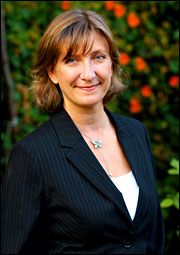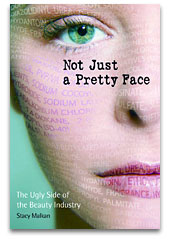
Stacy Malkan.
Beauty, they say, is only skin deep. But given the load of toxic chemicals in everyday products like shampoo, deodorant, and makeup, that superficial truth is still cause for concern. With increasing frequency, studies point to hidden dangers in the medicine cabinet: things like lead in lipstick, phthalates in baby lotions, aluminum in deodorant. While the amount of each toxic may be tiny on its own, the number of products most people use each day means we’re exposing ourselves to unnecessary risks — all in the name of looking and smelling good.
In 2002, the Campaign for Safe Cosmetics — a coalition of health, labor, environmental, and consumer-rights groups — began fighting to protect people around the world from these risks, by pressuring companies to change their formulas and by raising awareness among the public. The latest tool in this effort is Not Just a Pretty Face, a book by CSC co-founder Stacy Malkan.
Malkan, a former teen beauty queen, first became aware of the impacts of routine chemicals on humans as a reporter in Colorado; after a stint in politics in Washington, D.C., she got involved in Health Care Without Harm, a global coalition working to reduce pollution in the health-care sector. It was there that she first learned of the dangers of everyday products. Now living in Berkeley, Calif., Malkan splits her time between HCWH and CSC; I spoke with her by phone about her Aqua Net-clouded past, how she’s getting the word out to women and men alike, and the most surprising thing she’s seen along the way.
How did this book come about?
For five years, I was working with some of the top researchers and advocates in the field of environmental health, and seeing amazing stories, learning about the science, seeing many disturbing trends — and I just saw a great [chance to tell a story through the] people I was getting to know: women taking on big corporations, teenagers lobbying for political change, companies making safer products, chemists thinking of new, safer ways to create chemicals. There’s a lot of reason for hope, even though the topic can be overwhelming.
But it is upsetting to learn about all the toxins that we’re exposing ourselves to … through products we’ve trusted and used for years. When you start to think about all of the products you use in a day, or a week, the numbers are just staggering.
You measured the products you’d used as a teenager, right?
Yes, when I went back and looked at my former teenage beauty routine, I found that I was using 20 products a day and exposing myself to 230 chemicals before even getting on the school bus. Through this elaborate morning routine of makeup and skin cream and all sorts of hair products topped off with an enormous cloud of Aqua Net Extra Super Hold hairspray, I was exposing myself to 17 carcinogens, two dozen endocrine disruptors, and 15 different kinds of fragrance.
And that’s not unusual, I’m guessing.
Absolutely. Women use an average of about a dozen products a day, and men use about six, according to our surveys. Teenagers tend to use a lot more products — and at younger and younger ages. There was a [news] story just the other day … about how hairdressers are seeing girls as young as 10 in the salons getting hair dyes, and it used to be more like 16 or 17. Companies market hair relaxers at very young African-American girls — girls aged 5 and 8 are on the packages. And these are highly toxic beauty treatments.
What kind of response are you getting to the book?
People are just hungry for information on this topic — we’ve had more than 2,000 people come out to our events in the last few months … from junior-high and high-school audiences, to older women, and men too, people want to know about the products they’re putting on their bodies. It’s disturbing [to discover] that the mainstream companies, the ones that advertise so heavily, have not been willing to change their ways. But there’s a very inspiring part of this story as well, and I try to get that across.
I’m hearing that while people at first feel overwhelmed, when they go through the process of really looking at products and making changes, they start to feel empowered. Because ultimately we do have control over the products that we bring into our homes. And we do have the power to change the beauty industry and to say no to their toxic products and the toxic messages they bombard us with every day.
Have you seen any indication that big companies will budge on this?
We have seen some major changes. We saw a huge shift in the nail products market, where most companies have now removed what we called the “toxic trio” — dibutyl phthalate, toluene, and formaldehyde — which were quite commonly used in about half the nail polishes on the market. We focused on those products because dibutyl phthalate is banned in Europe, so we went to the companies and said, “Why don’t you take this out of products you sell in the U.S.?” At first there was resistance, but one by one the companies started to change … it happened quickly, and we still have nail products, and prices didn’t go up. So that’s an indication that the industry can change on a dime, if consumers demand it.
I’m hopeful that some of them are making quiet changes, because … the markets are changing, more people are demanding safer products, and political will is building. Currently nine states are considering legislation to restrict toxic ingredients in personal care products. So there’s increasing regulatory pressure.
Do you have any hope, in terms of regulation, that the U.S. will catch up to Europe?
I think we will see regulatory changes in the U.S. First of all, Europe is forcing U.S. companies to change whether or not the U.S. government is involved. The electronics industry had to reformulate all of their products to comply with E.U. law … Europe also, with the REACH legislation, will be requiring safety tests on thousands of chemicals over the next several years, so we’ll be getting a lot more information about chemicals that companies can use to make better choices.
In terms of political change in the U.S., I do think we see building political will for change … Maine and Washington just passed very progressive product safety laws. California is considering a bill that would ban lead in lipstick and a series of toxic chemicals from children’s products. It’s a step in the right direction — ultimately, we need change at the federal level.
What advice do you give consumers trying to find safer products?
First of all, simplify — I think that’s the main rule of thumb. Less is better. Look for products with fewer synthetic chemicals, use fewer products overall, try to avoid synthetic fragrance and parabens … You can also use the Environmental Working Group’s Skin Deep Database to look up product safety.
It’s important to look particularly at children’s products … it’s unbelievable what they put in [some of] these products. Many actually contain a warning label. I’m looking at a bottle of Strawberry Shortcake bubble bath — it’s a very cute container, and it says right on the back, “prolonged exposure may cause irritation to skin and urinary tract.” So it’s not a good idea to put kids in a bathtub full of chemicals if you can avoid it.
What about cost — don’t safer, natural products tend to cost more, and does that make this an environmental justice issue?
It’s true that natural products tend to cost more, and also are not available everywhere, so that is an environmental justice issue. But it’s also true that many of us spend a lot of money on beauty products of all types. If you start to simplify, you may find that you spend less money overall. For example, I’ve stopped coloring my hair, and we’ve stopped buying certain products like bubble baths, air fresheners, perfumes … I certainly spend less in a year on beauty products now, even though my shampoo’s a little more expensive.
Of all the things you’ve seen and heard in this work, what’s been the most shocking?
The information about breast cancer and the pinkwashing that goes on, where companies market their products to raise money for cancer research, and yet those companies [sell] products that contain carcinogens. I believe those companies have a responsibility to step up as champions for women’s health, and figure out how to get carcinogens out of their products, and be part of the solution rather than the problem. So far, they haven’t been willing to do that.
It’s also disturbing to read about some of the beauty trends in Asia — the huge pressure on women to use skin-lightening creams, and this constant bombardment of advertisements with Caucasian-looking actresses and models … We’re all being targeted with messages that make us feel like we have to be different than we are: lighter hair, straighter hair, lighter skin, darker skin, plumper lips, no wrinkles. This industry has way too much power over our minds, our sense of selves, and even our bodies as they continue to expose us to toxic chemicals.
Increasingly I’m seeing references to women’s power, as consumers, to make environmental changes. Do you think that’s the case?
Yes. The real story is that we have the power. We have the power to say no, I’m not going to buy your toxic products. No, I’m not going to believe your messages about how I need to be. Yes, I’m going to invest in companies that are doing the right thing, that are making safer products. As the largest bloc of voters in the U.S. and as the primary shoppers, women have the power to change the entire economy.
Do you ever worry that the message of this campaign is lost on men?
It’s harder to get the attention of men on these issues, but men are affected too. They use products — cologne, deodorant, shaving cream — and some of these chemicals impact men more so than women. An example is phthalates … there are many animal studies showing that phthalate exposure causes infertility, sperm damage, testicular tumors, and other problems that have been rising over the past few decades among men in industrial countries.
You say the fact that green groups and health groups are teaming up on this issue seems to get attention from the [cosmetics] industry — why is that?
When the Breast Cancer Fund and other health groups are involved, it points to the fact that we’re talking about health issues — that protecting the environment is about protecting our health. The same chemicals running through the rivers are running through our veins. I think this issue really points out the truth that we’re all connected and all of these challenges we’re facing are connected.
This problem has the same roots as global warming — we’re relying on outdated polluting technologies and fossil fuels. Many of the chemicals that make up cosmetics and plastics and other products in our homes are derived from oil. Our addiction to oil is causing many problems, from global warming to increasing rates of cancer and falling rates of fertility. It’s the same problem and the same set of solutions — what we need to do is reinvent the economy so it’s compatible with life and health, and we do that by pushing renewable energies, clean production, and green chemistry. Basically we need to reinvent the way we do everything — but that’s an exciting opportunity. That’s the business opportunity of the 21st century.



